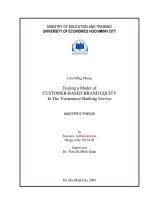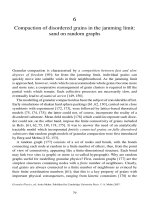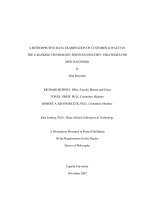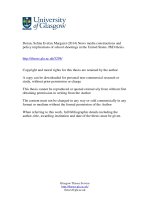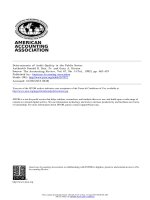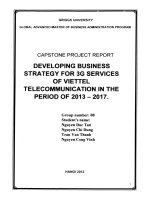DETEMINANTS OF BRAND LOYALTY IN THE VIETNAMESE BEER INDUSTRY
Bạn đang xem bản rút gọn của tài liệu. Xem và tải ngay bản đầy đủ của tài liệu tại đây (483.42 KB, 73 trang )
NIVERSITY OF ECONOMICS HO CHI MINH CITY
International School of Business
NGO HOANG THI QUYNH OANH
DETEMINANTS OF BRAND LOYALTY IN THE
VIETNAMESE BEER INDUSTRY
MASTER OF BUSINESS (BY HONOUR)
Ho Chi Minh City – Year 2012
UNIVERSITY OF ECONOMICS HO CHI MINH CITY
International School of Business
NGO HOANG THI QUYNH OANH
DETEMINANTS OF BRAND LOYALTY IN THE
VIETNAMESE BEER INDUSTRY
STUDENT ID: 60340102
MASTER OF BUSINESS BY HONOUR
SUPERVISOR: DR. PHAM NGOC THUY
Ho Chi Minh City - Year 2012
ACKNOWLEDGEMENTS
I would like to express my sincere gratitude to Dr. Pham Ngoc Thuy who has
supported me a lot with the thesis preparation and motivated me throughout the
journey of the thesis.
I strongly believe that I could have not completed this thesis without the
assistance from all of my friends who helped me to guide the customers to do
the survey and chased for data submission.
I would like to thank Sabmiller staffs for there is kind support to provide me
with necessary information and materials.
And finally my special thanks to my husband who was always with me to show
his empathy and encourages me to complete this thesis.
December 8, 2012
Ho Chi Minh City, Viet Nam
Ngo Hoang Thi Quynh Oanh
ABSTRACT
In recent years the amount of beer consumption increased significantly. The
beer companies increasingly expand the market and increase the retailer to take
the company's image and products to market. The purpose of attracting
customers to used the company's products more and more. This research is to
identify the determinants affecting customer loyalty through beer products. It
also requires investors in times of abundant commodities, constant competition
and especially during storms today.
This study was aimed to explore these factors affect brand loyalty in Ho Chi
Minh City is done through quantitative methods. Formal quantitative research
through interviews using a questionnaire with a sample collected in a
convenient method of 200 consumers in Ho Chi Minh City. Data are used to
assess the scale and test hypotheses. Cronbach Alpha coefficients analysis,
explore factor analysis (EFA) and regression analysis used in this section. Test
results obtained show that the hypothesis consistent with the original theoretical
model. According to which only some components of the factors affecting
consumer loyalty for beer products, including value factors have the strongest
impact.
The research results contribute to the theoretical basis of research by
understanding the meaning of the factors that affect consumer loyalty with beer.
Thereby, the results also provide managers with a basis for decision-making,
investment options to develop new products in line with objectives and current
strategic.
Key words: Perceived value, Brand Image, Brand Awareness, Brand Loyalty
TABLES OF CONTENTS
1.1 BACKGROUND 1
1.2 PROBLEM STATEMENT 2
1.3 RESEARCH OBJECTIVES 4
1.4 SCOPE OF STUDY: 4
1.5 SIGNIFICANCE 5
1.6 STRUCTURE OF THE THESIS STATEMENTS 5
2.1 BRAND 6
2.1.1 Traditional viewpoint of Brand: 6
2.1.2 Synthetic viewpoint of Brand: 7
2.2 BRAND EQUITY 7
2.3 CUSTOMER-BASED PERSPECTIVE OF BRAND EQUITY 9
2.3.1 Brand Image 12
2.3.2 Brand Awareness 13
2.3.3 Perceived Value 14
2.3.4 Brand Loyalty 15
2.4 RESEARCH MODEL, HYPOTHESIS 17
2.4.1 Research Model and hypothesis 17
3.1 RESEARCH PROCESS 20
3.2 MEASUREMENT SCALES 24
3.2.1 Measurement Scales 24
3.3 SAMPLING METHOD 27
CHAPTER 1: INTRODUCTION
1
CHAPTER 2: LITERATURE REVIEW & THEORETICAL MODEL
6
CHAPTER 3: RESEARCH METHODS
20
3.3.1 Target population and sampling method 27
3.4 MAIN SURVEY AND DATA COLLECTION. 28
3.5 DATA ANALYSIS METHODS 28
3.5.1 Exploratory Factor Analysis (EFA) 28
3.5.2 Reliability Analysis 29
3.5.3 Multiple Regression Analysis. 29
4.1 DESCRIPTIVE DATA ANALYSIS 31
4.1.2 Descriptive analysis of the variables studies 32
4.2 MEASUREMENT SCALE ASSESSMENT 33
4.2.1 Cronbach Alpha Reliability Analysis 33
4.2.2 Exploratory Factor Analysis 35
4.2.2.1 EFA analysis results for measurement scales of independent factors
(Brand awareness, Perceived Value, Brand Image) 35
4.2.2.2 EFA analysis results for measurement scales of dependent factor (Brand
loyalty) 37
4.2.2.3 Testing relationship of independent factors and dependent factor 38
4.3 HYPOTHESES TESTING 40
4.3.1 Testing Assumption of multiple Regressions 40
4.3.2 Evaluate and test the relevance of the model 41
4.3.3 Testing hypotheses on the impact of Independent factors on Brand Loyalty 42
4.4 DISCUCSIONS 45
4.4.1 Regression analysis results Regression standardized regression coefficient Beta: 45
4.4.2 Brand Awareness 45
4.4.3 Brand Image 46
4.4.4. Perceived Value 46
4.5 SUMMARY 46
CHAPTER 4: DATA ANALYSIS
31
5.1 RESEARCH OVERVIEW 48
5.2 KEY FINDINGS 49
5.3 MANAGERIAL IMPLICATIONS 49
5.4 CONTRIBUTIONS OF THE STUDY 50
5.4.1 Contributions of theory 50
5.4.2 Contribute to practical 51
5.5 LIMITATIONS OF TOPICS AND NEXT RESEARCH PLANS 51
CHAPTER 5: CONCLUSIONS AND IMPLICAT
IONS
48
REFERENCES LIST
APPENDIX 1
.
APPENDIX 2
.
APPENDIX 3
.
LIST OF TABLES
LIST OF FIGURES
Table 4.1: Descriptive Statistics of Sample 32
Table 4.2: Reliability analysis results. 34
Table 4.3 EFA analysis results for the independent variables after handling 356
Table 4.4 EFA analysis results for dependent – Brand Loyalty 37
Table 4.5: Multiple Regressions results of Brand Loyalty to independent 39
Table: 4.6 Result of hypotheses testing between Independent Factors and Brand Loyalty 42
B ng 4.7: Hypotheses Testing Results 453
B ng 4.8: Summary results of the hypotheses 45
Figures 1 – Prpoposed Research Model
17
Figure 2 - Research Process
22
Figures 3 - Research model after testing by EFA
40
Figures 4 – Multiples Regression Result
44
1
CHAPTER 1: INTRODUCTION
This chapter introduces the context of the study, including a short introduction
of beer industry in Viet Nam the purpose of this study and the other contents
such as the rationale of the research, problem statement and research
methodology.
1.1 BACKGROUND
Vietnam has a young population and is a potential market for the beer industry.
With a growth market with two figures and capita consumption of beer in just
21lit/person (VBA, report 2009) is still low compared to world average of
results strongly attractive for any business. Present on the Vietnamese market
are over 30 types of beer exist stretches from North to South. These products
are well-known consumer must mention Heineken known, Sai Gon blue,
Castbreg, 333 And most recently of Sapporo of Japan and Gambrinus of
Czechoslovakia have penetrated the market more "lucrative" is. These products
are primarily levied on customers with high income and geographic distribution
mainly in the central districts of the city, or the neighboring provinces, where
many tourists visit.
According to the VBA, report 2010
"In VBA, in recent years, Vietnam's beer has made great progress.
Ended in 2009, the industry reached 2.5 billion liters in volume. Most
businesses produce wine, beer and soft drinks in VBA with an average
growth rate of 15% compared with 2008. Currently, Vietnam has about
350 beer production facility, which has 20 factories with a capacity of 20
million liters/year. Every year, the sector to create jobs for thousands of
workers and pay tens of billion budgets"
2
1.2 PROBLEM STATEMENT
As Amy et.al. (1999) stated: “In order to achieve competitive advantage and
efficiency, businesses have to seek profitable ways to differentiate themselves.
The only to survive and maintain customer revisits is to understand what
customers need and their expectation. Customer satisfaction is considered a
prerequisite for customer retention and loyalty, and obviously helps in realizing
economic goals like profitability (Sureshchandaret al., 2002).
We outline some beer company information is currently available in Vietnam
market and these beers have the same level premium as follow.
Vietnam Brewery Company Limited (VBL), beer production units Tiger,
Heineken in Vietnam, is a joint venture established on 09/12/1991, between
Saigon Trade Corporation (SATRA) and Asia Pacific Breweries Ltd group.
(APBL), head quartered in Singapore. Having been in Vietnam for nearly 20
years, the world's leading beer brand Heineken conquered by consumer
premium quality no one can match with beer. For Heineken, the promotional
gentle, subtle make consumers feel secure when using the product. Messages
for promotions is very simple "old Heineken beer is about to leave and was
replaced by 5% premium Heineken."These elements are conveyed through PR
with the message" Heineken has changed "vividly expressed through a
campaign with the help of top photographer Rankin. He has photographed
celebrities 7
th
most UK and changes each face with each other to express the
main message of the campaign. In addition to strengthening the Heineken brand
has also launched a campaign based on the idea of "Heineken has been tested on
the streets all over the world and make sure that Heineken is the best choice for
you". It is expressed through many pictures to show people that Heineken beer
is interested in worldwide (vblgroup.vn)
3
Sai Gon beer, products on the market for more than 30 years has become a
destination for lovers of this beer. The company has done well with the
promotion of diverse forms of promotion, rich, attractive, with the prize of great
value, attracting a large number of consumers to participate, promote
consumption of products beer. Recent, Sabeco Company has launched the
marketing promotion as “Together Saigon beer to double happiness“ and" drink
Sai Gon beer hit SH motor" and achieved good results.
SABMiller is one of the largest multinational beer companies in the world with
headquarters in the UK, owns over 200 beer brands known worldwide, have a
thickness of over 100 activities in 60 countries with a total staff of about 68,000
people. SABMiller Vietnam with 100% foreign capital from the SABMiller
Group, known for products such as Peroni Nastro Arruzzo, Pilsner Urquell,
Gambrinus, Zorok, Miller, Castle Penetrate new markets in Vietnam, but not
height or Sai Gon special as Tiger, Heineken velvet Gambrinus also pretty
impressed with the way consumers through marketing "How to open bottle cap
hit right trip Czechoslovakia" cradle of beer Gambrinus is the people this
country exists as the "King of beers” .(Sabmiller.vn)
One of the important issues is to keep the current customers purchasing and
using the service and repeating using service. Moreover, for Vietnamese, the
more loyalty a customer has toward a certain brand, the more chance that brand
is introduced to new customers via the “word-of-mouth”. In response to this
issue, companies tried launching attractive promotions in order to attract the
loyalty of customers for their products.
Customer loyalty for a brand that speaks to the trend of customers to buy and
use brand in a product family and repeat this behavior (Chaudhuri 1999). Brand
loyalty plays important role in the success of the brand. So which brand create
higher customer loyalty, bring profit to the company as higher, which means
that this brand of high value (Aggarwal P (2004)
4
Given the above mentioned situation, measuring customers’ perception for beer
brand equity becomes very important and necessary. It will be the basis for
improving the brand equity for beer industry. Research results contribute to
research on the basis of the theory of brand loyalty through understanding the
meaning of the factors that affect consumer loyalty to the brand. Thereby, the
results also provide for investor how to keep customers loyal to the brand,
which is why this study performance, results of topics beer companies can be
used
1.3 RESEARCH OBJECTIVES
The overall objective of this research is to measure the loyal of customer based
brand equity for beer industry on Viet Nam, then to develop the specific
program to improve it.
Specific objectives in this research are as follows:
To identify the impacts of Brand Equity components (Brand Awareness,
Perceived value, Brand Image) on the Brand Loyalty in beer industry on
Viet Nam.
1.4 SCOPE OF STUDY:
This study will be mainly based on the customer-based perspective of
Brand Equity only. The financial perspectives of the brand equity are
beyond our scope of study. The research was narrowed down to Ho Chi
Minh City.
This study focus drinker. Owner, shop, wholesaler only reference to
establish questionnaire.
Focus on brands have same level premium: Heineken, Sai Gon special ,
Sapporo, Gambrinus, Tiger.
5
This study will consist of two main parts which assigned individually to
each author. Part 1 focus on the creation of information, data analysis;
part 2 will be the improving program based on these findings.
1.5 SIGNIFICANCE
Research results will determine the factors affecting brand loyalty. Since then
the manager have plan to develop appropriate strategies to promote their
products to consumers more and more widely.
1.6 STRUCTURE OF THE THESIS STATEMENTS
The structure of this research report consists of five chapters. Chapter 1
introduces the overview of the research topic. Chapter 2 presents the theoretical
basis of the concepts involved, theoretical modeling with the proposed
hypothesis. Chapter 3 presents the research methodology to test the scale and
theoretical models offered. Chapter 4 presents the results of the implementation
of the testing and analysis of information and data from which to draw
conclusions for the research hypotheses proposed in Chapter 2. Chapter 5
summarizes the main results of the study, the contribution of management
theory and practice and also mentioned the limitations of research to guide
subsequent studies.
6
CHAPTER 2: LITERATURE REVIEW & THEORETICAL
MODEL
First of all, key concepts in the current study such as Brand, Brand Equity,
Customer-based Equity, Brand Loyalty, Strategic Brand Equity Management
and their role and importance in business activities will be reviewed
2.1 BRAND
The term “brand” has multiple meanings and different perspectives. Kreutz
(2004) indicated that Brand identified products and services, but a brand was
much more than a brand name or a brand logo on a brand-name product. He
also suggested further that brands reflect individual and collective desires that
go far beyond a product’s utilitarian benefit. Otherwise, he further explained the
brands to be presented by signs and symbols, gestures and images.
From service perspective, Blankson and Kalafatis (1999) suggested the service
brands are particularly different from product brands in which characteristics of
services brand are different from those of physical goods and they relied on
employees’ actions and attitudes.
From the financial perspective, according to Murphy (1990), a brand was not
only an actual product, but the unique property of a specific owner. It has been
developed over time so as to embrace a set of tangible and intangible attributes
that appropriately different products.
In general, there are two main viewpoints about brand, namely traditional view
and synthetic view.
2.1.1 Traditional viewpoint of Brand:
The American Marketing Association (AMA) defines a brand as a name, term,
sign, symbol, or design, or a combination of them, intended to identify the
7
goods and services of one sellers or group of sellers and to differentiate them
from those of competition ( in Tho et al, 2002).
From this viewpoint, brand is understood to be one component of products and
main character of brand are used to differentiate this product from other
product. Example, in some cases, the company name was essentially used for
all products as with General Electric and Hewlett- Packard. In other cases,
manufacturer assigned individual brand names to new products that were
unrelated to the company name as with Proctor & Gamble.
2.1.2 Synthetic viewpoint of Brand:
Brand is not only a name or logo or sign but it is much more complicated
(Davis, 2002). In this viewpoint, product is only a component of brand and so
products, price, distribution, promotion are components of brand (Amber and
Styles, 1996)
This view has been increasingly applied and accepted by researchers and in
practice also.
The fact is that customers have two needs including functional needs and
emotional needs. Product could only provide the functional needs for
customers, while brand could provide both functional needs and emotional
needs for customers. This is the explanation for why brand has been replacing
products in marketing activities of most companies nowadays.
2.2 BRAND EQUITY
Brand equity has been considered in many contexts: the added value endowed
by the brand name (Farquhar, 1989). This concept is defined from different
perspectives by many authors around the world. In general sense, according to
Keller (1991), Brand Equity is defined in terms of marketing effects uniquely
attributable to the brand, e.g., when the different outcome result for a product or
8
service because of its brand name as compared to if the same product or service
did not have that name.
Aaker (1991) defines brand equity as a set of brand assets and liabilities linked
to a brand, its name and symbol, that add to or subtract from the value provided
by a product or service to a firm and/or to that firm’s customers.
In other word, brand equity is the incremental value of a product due to the
brand name (Srivastava and Shocker, 1991)
According to some leading authors in brand management (Keller, Aaker,
Lassar, Srivastava, Shocker, Prasad and Dev ), brand equity can be studied
from different viewpoints:
Customer-Based perspective ( Keller,1993; Aaker,1996)
The importance of understanding brand equity from customer’s point of
view is explained by Keller (1993) as positive customer based brand equity
can lead to a greater revenue, lower costs, and higher profit, it has direct
implications for the firm’s ability to command higher prices, customer’s
willingness to seek out new distribution channels, the effectiveness of
marketing communications, and the success of brand extensions and
licensing opportunities.
Financial perspective (Srivastava and Shocker, 1991, Kim et al , 2003)
Brands are increasingly considered primary capital in many businesses. The
notion that a brand has an equity which exceeds its conventional asset value
has been developed by financial professionals (Kim et al, 2003). The
financial perspective is based on the incremental discounted cash flows that
would results from a branded product’s revenue over the revenue of an
unbranded product (Simon and Sullivan, 1993).
9
Some studies have found that a product’s brand equity positively affects
future profits and long-term cash flow (Srivastava and Shocker, 1991).
Combined perspective (Dyson et al,1996; Motameni and Shajroki,1998)
Brand equity therefore is a broad concept and has various perspectives.
However, due to the scope of the study and the main reason in which I have
to identify where they are in the eyes of the customers, so , this research will
only focused on the first perspective (i.e. customer - based brand equity -
CBBE).
2.3 CUSTOMER-BASED PERSPECTIVE OF BRAND EQUITY
Keller (1991) defined Customer-Based Brand Equity (CBBE) as the different
affects that knowledge about the brand has on consumer’s responses to
marketing activities for the brand. He also mentioned that Customer-Based
Brand Equity involved how customers react to company’s marketing mix action
for a given brand, as compared to how they react if the same actions were
attributed to a hypothetical or unnamed version of the product or service.
Customer-Based Brand Equity happens when the customers get used to with the
brand and hold some favorable, strong, and unique brand associations in
memory (Keller, 1991)
Keller (1993, 1998) also suggests that brand equity is customers’ knowledge
and Customers’ knowledge included two main components, namely brand
image and brand awareness.
Aaker (1996) defined brand equity as a set of brand assets and liabilities linked
to a brand- its name and symbol-that adds to or subtracts from the value
provided by a product or service to a firm or to the firm’s customers. In another
way, Blackstone (1995), considered brand equity as brand value and brand
meaning, where brand meaning implied brand saliency, brand associations, and
brand personality, and where brand value was the outcome of managing the
10
brand meaning. Keller (1993) also defined it as the differential effect of brand
knowledge on consumer response to the marketing of the brand.
Lassar et al (1995) operationalised brand equity as the enhancement in the
perceived utility and desirability that a brand name confers on a product. Lassar
(1995) proposed 5 components of brand equity including perceived quality,
perceived value, brand awareness, brand trustworthiness and brand
commitment.
Lassar further suggested that CBBE included only perceptual dimensions,
excluding behavioral or attitudinal dimensions such as usage intention or
loyalty. Unlike others, Aaker(1991) suggested main components for CBBE:
brand loyalty, brand awareness, perceived quality and brand image.
With different viewpoints on the brand equity described above, it can be seen
that brand equity is a complicated concept which consists of many components,
and, possibly these components could include various sub-components. Many
authors have the same approach to the brand equity components: most of them
admit the presence of brand awareness and perceived quality in brand equity.
However, there are still some different viewpoints among the authors, for
example Lassar believes perceived value, brand trustworthiness and brand
commitment are other dimensions in brand equity concept, but for Aeker,
brand loyalty and brand image are the other components.
There is an indirect approach and a direct approach to measure consumer-based
brand equity (Keller, 1993). The direct approach requires measuring brand
awareness and the characteristics and relationships among brand associations.
Brand awareness can be assessed effectively through a variety of aided and
unaided memory measures that can be applied to test brand recall and
recognition. Brand associations can be measured by qualitative techniques such
as free association tasks that lead customers to describe what the brand means
11
to them, projective techniques such as sentence completion, and picture
interpretation, and brand personality descriptors. The direct approach, however,
requires experiments in which one group of customers responds to an element
of the marketing program when it is attributed to the brand and another group of
consumers responds to that same element when it is attributed to a fictitiously
named or unnamed version of the product or service (Kim et al, 2003)
The components of brand equity are different from one industry to other
industry. In the scope of this research for beer industry, we would mainly base
the brand equity concept suggested by Aaker whose components have been
broadly accepted and employed by many researchers (Keller, 1993; Low and
Lamb, 2000; Prasad and Dev, 2000; Yoo and Donthu, 2001). Also, we would
argue for the presence of one more component, brand affinity, which was
suggested by Ajzen & Fishbein in 1980 Also, a recent study for customer
behavior toward different shampoo in Vietnamese market, Dr Nguyen Dinh
Tho and Nguyen Thi Mai Trang (2002) proposed a model as hereunder:
According to this model, Brand Loyalty is a component of Brand Equity.
However, it seems to become the results of interrelationships among these
components.
Brand
Awareness
Perceived
Quality
Brand Affinity
Brand Loyalty
12
Therefore, we suggest that the Customer-Based Brand Equity’s components for
the case of beer industry will include Brand Image, Brand Awareness and
Perceived Value. Brand loyalty will become the result of Customer-Based
Brand Equity.
2.3.1 Brand Image
According to Keller (1998), brand image is defined as perceptions about a
brand as reflected by the brand associations held in consumer memory. Besides
marketer-controlled sources of information, brand association can also be
created in variety of other ways: by direct experiences, from information
communicated about the brand from the firm or other commercial or
nonpartisan sources, word of mouth; and by assumptions or interferences from
the brand itself (e.g, its name or logo) or from the identification of the brand
with a company, country, channel of distribution, or some particular person,
place or event.
To Keller (2000), to increase brand image of a company, it is necessary focus
on improving its brand associations as follows:
Strength of brand associations: the more deeply a person thinks about
product information and relates it to existing brand knowledge, the stronger
the resulting brand associations. Two factors facilitating the strength of
association to any piece of information are the personal relevance of the
information and the consistency with which this information is presented
over time.
The next strongest associations are likely to be formed on the basis of word
of mouth or other noncommercial sources of information. Word of mouth is
likely to be particularly important for service industry (restaurants,
entertainment, banking, etc ).
13
The entire marketing program and all activities related to the brand will
affect the strength of brand associations.
Favorability of brand associations: choosing which favorable and unique
associations to link to the brand requires careful analysis of the consumer
and competition to determine the optimal positioning for the brand. In the
most basic sense, favorable brand associations are created by convincing
consumers that the brand possesses relevant attributes and benefits that
satisfy their needs and wants, such that they form positive overall brand
judgements. Thus, favorable associations for a brand are those associations
that are desirable to consumers and are successfully delivered by the product
and conveyed by supporting marketing program for the brand.(e.g, such that
the brand is seen as highly convenient, reliable ,etc).
Uniqueness of brand associations: brand associations may or may not be
shared with other competing brands. The essence of brand positioning is that
the brand has a sustainable competitive advantage or “unique selling
proposition” that gives consumers a compelling reason why they should buy
that particular brand. These differences may be communicated explicitly by
making direct comparisons with competitors, or may be highlighted
implicitly without stating a competitive point of reference.
2.3.2 Brand Awareness
Brand awareness is one component of brand equity (Aaker, 1991; Keller, 1998).
To Aaker (1991), Brand Awareness is the ability of a potential buyer to
recognize or recall that a brand is a member of a certain product category.
It consists of brand recognition and brand recall performance. Brand
recognition relates to customers ability to confirm prior exposure to the brand
when given the brand as a cue. In other words, brand recognition requires that
14
customers can correctly discriminate the brand as having been previously seen
or heard.(Keller, 1998)
Brand recall relates to consumers’ ability to retrieve the brand from memory
when given the product category, the needs fulfilled by the category or a
purchase or usage situation as a cue (Keller, 1998). Brand recall requires that
consumers correctly generate the brand from memory when given a relevant cue
. For example, recall of Ipod (Apple) will depend on customer’s ability to
retrieve the brand when they think of mp3 music player.
2.3.3 Perceived Value
From the consumer perspective, perceived value is defined as the consumer’s
overall assessment of the utility of a product based on perceptions of what is
received and what is given (Zeithaml, 1998). Chen and Hu (2010) suggest that
value can be formed by functional utility and non – functional utility.
Functional utility refers to tangible needs such as quality and price, while non-
functional utility refers to intangible aspects relating to reputation, social and
emotional needs. In the case of wine consumption, the functional utility is
investigated in terms of physical product judgment and non-functional utility is
considered under the construct of perceived non- physical value.
Based on various eating and drinking motivators suggested in the literature (
Renner Spronessor, Strohbach & Schupp,2012; Somogyi, et al.,2011) and the
value framework proposed by Williams and Soutar (2009), the current study
focuses on two reflective components of perceived value when a consumer
drinks wine, namely emotional value and social value.
Emotional value is a social-psychologial dimension that reflects a product’s
ability to arouse feeling or affective states (Sheth, Newman & Gross,1991). In
wine consumption, emotional value represents the extent of pleasure,
indulgence, and relaxation or cheer a consumer may feel while drinking it
(Renneret al. ,2012). Social value is defined as “the perceived utility acquired
15
from an alternative’s association with one or more specific social group” (Sheth
et al.,1991,p. 161). Consumer choices of goods to share with other people like
wine are often driven by social value (Williams & Soutar.2009). In a
collectivistic culture like Vietnam, most people drink wine other people in a
group. In these circumstances, wine is an important utility of wine consumption.
Between the two components, emotional value is to reflect the fulfillment of
internal need for stress release, relaxation, pleasure, fun, ect. In contrast, social
value is associated with external need when consuming wine. It relates to the
practive of social relationships with others like social gathering, business
events, ect. (Renener et al.,2012; Brunner& Siegrist,2011).
2.3.4 Brand Loyalty
Customers’ loyalty about any brand would like to tell their tendency of
purchasing and using a product and repeated using that product (Chaudhuri,
1999). The concept of brand loyalty is a vital component of brand equity. It has
been found to have a positive and direct role in affecting brand equity (Atilgan
et al, 2005).
According to Aaker (1991), brand loyalty is a basis of brand equity that is
created by many factors, chief among them being the use of experience. Keller
(2000) stated that brand loyalty certainly seems to be key variable for
management interested in the value of brand equity when measure from a
consumer perspective.
Also, from Kotler (2003), brand loyalty plays important role for the success of
product. The marketers show that many companies had illusions to find new
market and to forget bringing up current market, while profit gaining from
current market is much higher than new market due to low marketing expense.
Therefore, higher brand loyalty from customers is higher profits for company.
16
Table 2.1 Summary components impact to Brand Loyalty
No Components Content Author / Year
1
Brand
-
Traditional viewpoint of
brand
Kreutz (2004), Blankson and
Kalafatis (1999),
-
Synthetic viewpoint of
brand
Davis (2002),Amber and Styles
(1996)
2
Brand equity
-
Customer-Based
perspective
Keller (1991), Aaker (1991)
-
Financial perspective
Srivastava and Shocker(1991), Kim et
al (2003),
-
Combined perspective
Dyson et al (1996). Motameni and
hajroki,1998)
3
Customer-based perspective of brand equity
Brand image
-
Strength of brand
associations
Keller (1993, 1998) ,Aaker (1996)
,Lassar et al (1995) ,Kim et al (2003)
-
Favorability of brand
associations
Dr Nguyen Dinh Tho and Nguyen
Thi Mai Trang (2002), Keller (1998)
-
Uniqueness of brand
associations
Keller (1998), Aaker (1991).
Brand awareness
Zeithaml (1988),Chen &Hu (2010)
Perceived value
Zeithaml (1998). Chen and Hu
(2010), (Sheth, Newman & Gross
(1991),Sheth et al.,(1991)
4
Brand
Loyalty
Chaudhuri (1999), Atilgan et al (
2005),Aaker (1991), Keller
(2000),Kotler (2003),
17
2.4 RESEARCH MODEL, HYPOTHESIS
2.4.1 Research Model and hypothesis
Brand loyalty has closely relation with the components of CBBE including
Brand Awareness, Brand Image and Perceived Value. Before customers are
loyal with any brand, they normally are aware that brand and then they have an
affinity for consuming that brand and also have perception about the quality of
that brand. So it is assumed that the brand loyalty of a product is positively
influenced by the customer – based brand equity.
For sustaining and increasing the loyalty of the current customers, beer industry
should know where they are standing in the heart of the customer by measuring
the relations between Brand Loyalty with the rest components (Brand
Awareness, Perceived Value and Brand Image).
In lines with the research problem and objectives, we assume to develop the
model which shows the relation between each components of CBBE for beer
industry as follows:
Figure: 1 - Proposed Research Model
Brand
Awareness
Brand Loyalty
Brand Image
Perceived Value
